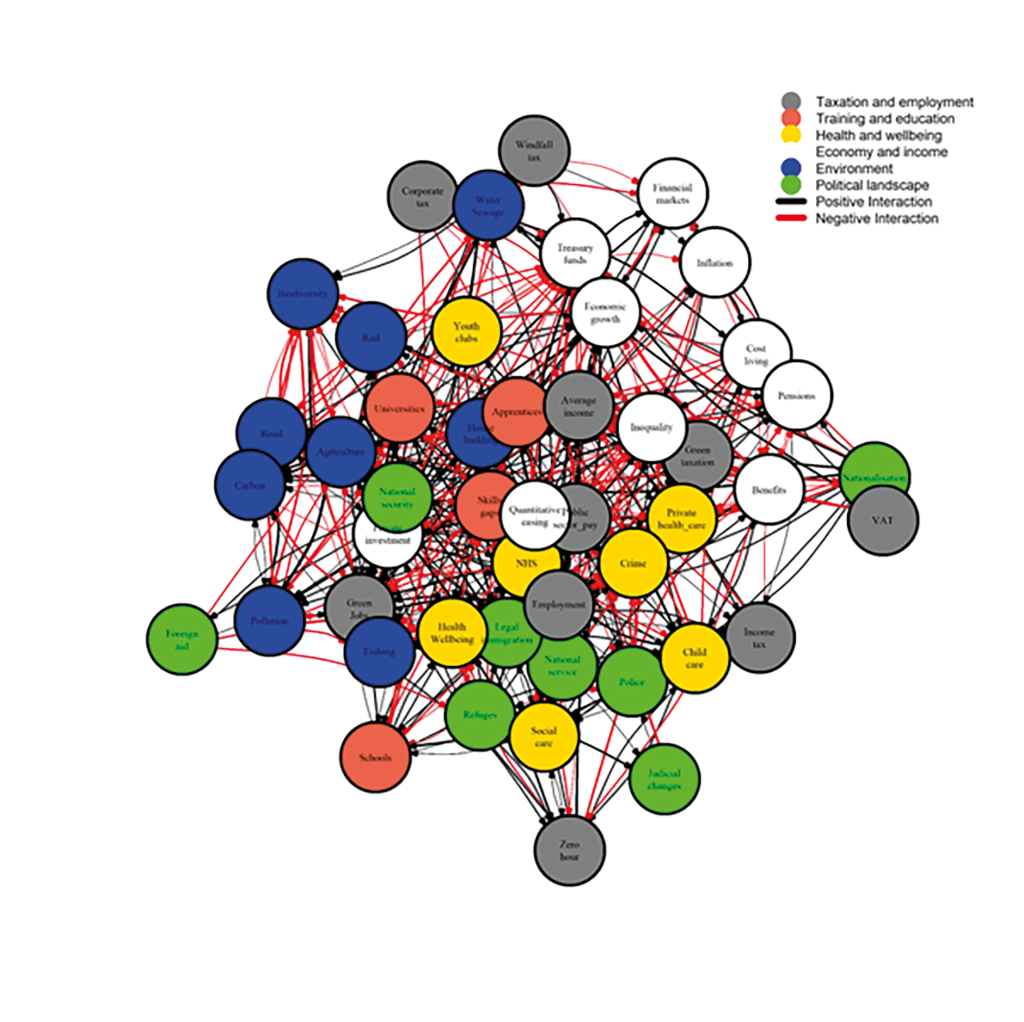
Prof Rick Stafford
Professor of Complex Systems and Environmental Policy at Bournemouth University. Research focuses on assessing effective policy interventions and solutions to complex problems, mainly in the environmental domain.
Twitter: @rick7575
Email: rstafford@bournemouth.ac.uk

UK Election 2024
Section 5: Policy and strategy
50. It’s the cost-of-living-crisis, stupid! (Prof Aeron Davis)
51. The last pre-war vote? Defence and foreign policy in the 2024 Election (Dr Russell Foster)
52. The 2024 UK general election and the absence of foreign policy (Dr Victoria Honeyman)
53. Fractious consensus: defence policy at the 2024 General Election (Dr Ben Jones)
54. The psycho-politics of climate denial in the 2024 UK election (Prof Candida Yates, Dr Jenny Alexander)
55. How will the Labour government fare and what should they do better? (Prof Rick Stafford and team)
56. Finding the environment: climate obstructionism and environmental movements on TikTok (Dr Abi Rhodes)
57. Irregular migration: ‘Stop the boats’ vs ‘Smash the Gangs’ (Prof Alex Balch)
58. The sleeping dog of ‘Europe: UK relations with the EU as a non-issue (Prof Simon Usherwood)
59. Labour: a very conservative housing manifesto (Prof Becky Tunstall)
60. Why the Labour Government must abolish the two-child benefit limit policy (Dr Yekaterina Chzhen)
61. Take the next right: mainstream parties’ positions on gender and LGBTQ+ equality issues (Dr Louise Luxton)
As expected, Labour have swept to victory in the UK elections. Labour have run a very cautious campaign, so it is fair to wonder what the next five years of Labour rule will look like. The party’s manifesto is a good starting place, but how do all the pledges and promises combine for the future of people living in the UK?
During the campaign, we built a complex system model to try and encompass as much of the UK political landscape as possible. Complex system models normally have simple relationships between different model components (e.g. more police result in less crime), but complex and often surprising ‘emergent’ properties (more police may not reduce crime, if other factors such as inequality aren’t reduced). We fed the model information from the manifestos of the main UK wide political parties (Conservatives, Labour, Liberal Democrats, Greens and Reform UK). Here we examine some of the main model outcomes, focussing on how well Labour faired out of the five parties, and what lessons they could learn from other party manifestos to perform better, based on model outcomes. The full details of the model and the results are available as a pre-print (not yet undergone peer review, which can take several months), but the types of models used have been peer reviewed before. Here we combine some model outcomes into broad themes that are public priorities, relating to personal finance, environment, immigration and public services.

(positive interaction: black arrows; negative interaction: red arrows) and between different categories of node (Taxation and employment: grey, Training and education: tomato red; Health and wellbeing: gold; Economy and income: white; Environment: blue; Political landscape: green).
Personal finance
Labour have been very cautious in relation to taxation, promising not to increase working people’s taxes. As such, they rank mid-way of the five political parties, neither raising nor cutting taxes. However, they are also mid ranking on benefits and pensions, and overall, for average (post taxation) income. Our analysis suggests Labour might have been too cautious here. The highest average incomes are achieved under the Green and Liberal Democrat policies, despite their willingness to raise taxes. In contrast, tax cutting parties such as Reform and the Conservatives resulted in lower average incomes, and higher levels of economic inequality. Counter to the popular narrative, tax rises may increase income for traditional Labour voters, who may become disillusioned under Labour’s tight fiscal rules.
Environment
Labour rank mid-table of the five parties in regard to the environment. Investment into carbon reduction, biodiversity and reducing pollution (including sewage pollution) was low compared to the Greens and Liberal Democrats, but commitments to the environment were not completely abandoned, as they were with the Conservatives and Reform. Another reason for poor environmental performance was a commitment to economic growth (Labour ranking highest on this factor, largely due to encouraging high levels of investment), which has been shown to be only partially able to decouple from environmental degradation. Ultimately, Labour cannot afford to ignore the environment for five years in a national or international context. They should focus on moving investment into green jobs (or public services with low environmental footprints such as the NHS and social care), rather than just boosting the financial sector and promoting economic growth for its own sake.
Immigration
Immigration is a contentious issue, but the popular viewpoint is that it needs to be lower. Labour score very highly on reducing immigration (tying for first place with Reform). Regardless of people’s beliefs on legal immigration, strong policies on employment, apprenticeships and zero-hour contracts are likely to be positive aspects which will make the UK workforce more able to compete with immigrant labour. Reversing Conservative declines in the foreign aid budget will also help reduce asylum seekers and refugees, again, a measure which should be seen as positive, regardless of your views on immigration. These policies combine with more direct, but less inflammatory policies than Reform or the Conservatives, although it should be noted, Labour’s policies and tone on immigration during the campaign have been criticised by some.
Public Services
We have predicted a very mixed bag for Labour here. Labour rank highly on improvements for state schools (largely due to an influx in funding from taxing private schools), yet very poorly on social care and the NHS (ranked second from bottom and bottom respectively). Largely, this was due to lack of investment in both areas. While promises of 40,000 extra NHS appointments per week were headline grabbing figures, this equated to an increase in only ~ 0.3% of the number of appointments. This contrasts with an increase in budget from the Green party of £28 billion (~16% of the budget), in addition to extra money for infrastructure repairs. Labour’s cautious plan might well build the economy and lead to more money to the NHS by the end of this current parliament, but if they fail to improve and invest in the NHS is likely to disillusion voters next time around.
Overall, our analysis found Labour policies aligned better with voter preference than the Conservatives, however, it is clear they may need to do more than already promised to remain a popular party and win a second term.
